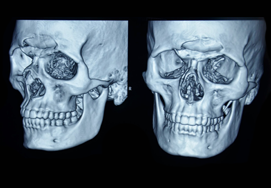TMJ Ankylosis Correction
Ankylosis of the temporomandibular joint refers to immobility or fusion of the joint, which occurs due to trauma or infection, or may be congenital or a result of Rheumatoid Arthritis.

- What is Temporomandibular joint Ankylosis?
- What are the causes of TMJ Ankylosis?
- What are the problems associated with TMJ Ankylosis?
- What are the treatments for TMJ ankylosis?
- How should I prepare for the surgery?
- What is the aftercare of the surgery?
What is Temporomandibular joint Ankylosis?
Temporomandibular joint ankylosis is a pathological condition where the mandible is fused to the fossa by bony or fibrotic tissues.
Ankylosis refers to stiffening (immobility) or fixation (fusion) of the joint. Chronic, painless limitation of the movements of the joint occurs.
Intra-articular (true) ankylosis must be distinguished from extra-articular (false) ankylosis. False ankylosis may be caused by enlargement of the coronoid process, depressed fracture of the zygomatic arch, scarring from surgery, irradiation, infection, etc.
True ankylosis of the mandible is one of the most disturbing articular pathology of TMJ, causing many psychological and physical disturbances. When the pathology affects both the joints it completely inhibits the movements of the mandible, making chewing, swallowing and speech very difficult.
The facial development is impaired resulting in retarded growth of the mandible. Since the condyle of the mandible is the growth center (area of bone growth) for the mandible, any disturbance in this region provokes a change in the development of the mandible.
True bilateral congenital ankylosis of the TMJ leads to micrognathia or “bird face”. If ankylosis affects only one side, it produces a lateral deviation of the jaw to the non-affected side, due to the fact that this side continues its growth normally. Therefore the deformity becomes more evident on the normal side, with deficiency on the ankylosed side, causing a facial asymmetry.
What are the causes of TMJ Ankylosis?
- Trauma to the joint during an accident, fall etc
- Disease or infection in the joint, ear infection etc
- Enlargement of the coronoid process
- Depressed fracture of the zygomatic arch, condylar neck fracture etc
- Surgery to or around the joint
- Rheumatoid arthritis
- Ankylotic conditions such as ankylosing spondylitis may also be inherited.
- Destruction of the joint cartilage
What are the problems associated with TMJ Ankylosis?
Problems associated with ankylosis of TMJ are manifold and can be functional, aesthetic (Cosmetic), psychological (emotional) or social.
Ankylosis of Temporomandibular joint may result in:
- Restricted jaw movements
- Inadequate masticatory (chewing) function
- Restricted mouth opening
- Inhibited facial and physical growth
- Impaired speech
- Reduced growth of mandible resulting in “Bird Face”
- Facial asymmetry if only one side is affected
- Difficulty in breathing and swallowing
- Snoring and difficulty in sleeping on lying down
- Insufficient access for dental care resulting in multiple decayed teeth
- Misaligned teeth because of lack of space for the eruption of the normal component of teeth
- Other emotional, social and psychological disturbances.
What are the treatments for TMJ ankylosis?
Over the past few decades numerous treatment methods have been designed and developed by for the correction of TMJ ankylosis.
- Excision of ankylosis (gap arthroplasty)
- Arthroplasty with or without autogenous, alloplastic or allogenic replacement
- Condylectomy if the ankylosis is intra-articular or an osteotomy of a part of the ramus if the coronoid process and zygomatic arch are also affected.
- Total condylectomy and joint replacement (autogenous, allogenic, alloplastic)
- Myotomy
- Coronoidectomy or coronoidotomy: This is the excision of the coronoid process of the mandible to release the temporalis muscle.
The goal of ankyloses surgery is to increase the patients mandibular function. Correct associated facial deformity. Decrease pain and prevent reankylosis.
How should I prepare for the surgery?
Before the surgery, your surgeon will provide certain instruction that include the following:
- Purchasing supportive pillows to make yourself feel comfortable
- By getting your prescription filled before the surgery
- Keeping a child sized tooth brush or a water-pik that can be useful after your surgery when you cannot open your mouth widely
- Foods and beverages to avoid:
- Tea and coffee
- Sodas
- Chocolates
- You should avoid drugs such as aspirin or anti-inflammatory
- You must quit smoking at least 3 months before your scheduled surgery
What is the aftercare of the surgery?
After the surgery, you must be careful enough and follow the following care aspects:
- You must be on the liquid diet and avoid chewing the food.
- Jaw exercises to be done religiously to maintain mouth opening
- You must apply ice pack to the side of the face
- You must take a shower with care and try to keep the surgical site dry
- You must change the dressing now and then as recommended by the surgeon, and also apply neosporin or antibiotic ointment to the site each time when band-aid is changed










